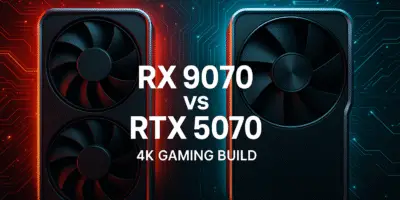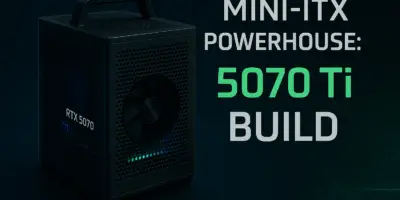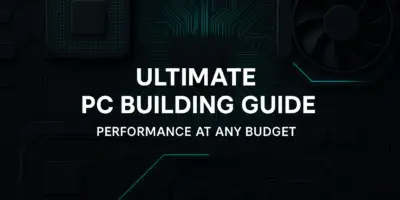Hey there, tech enthusiasts! I’m back with another budget-friendly PC build. This time, we’re looking at what $300 can get you in 2025. Spoiler alert: it’s actually pretty impressive!
Let’s face it—not everyone has thousands to drop on a high-end gaming rig. Whether you’re on a tight budget or just looking for a secondary system, this build might be exactly what you need. I’ve tested it with several games and benchmarks, and I’ve got to say, I’m genuinely impressed with what this little machine can do.
Table of Contents
The Parts Breakdown
Motherboard: MSI B450M PRO-MAX 2
Starting with the foundation, we’ve got the MSI B450M PRO-MAX 2 motherboard. It features two RAM slots and one M.2 Gen 3 slot. While the name might be a mouthful (seriously, why do motherboard manufacturers make these names so long?), it’s a solid board for our budget build.
The strongest processor this board can handle without issues is the Ryzen 7 5700X running at stock speeds. At 65W power consumption, the board can deliver enough power without breaking a sweat. Push it with overclocking, though, and you’ll exceed what this board can handle power-wise.
Processor: Ryzen 5 4500
For this build, I went with the Ryzen 5 4500. It’s a bit of an underrated gem—you don’t hear much about the 4000 series compared to the 3000 or 5000 series chips. This processor performs similarly to the Ryzen 5 3600 and 5500, making it an excellent value pick.
The Ryzen 5 4500 comes with six cores and twelve threads, with a base clock of 3.6GHz and a boost clock of 4.1GHz. With a power consumption of only around 65W, we don’t need an expensive cooler or a high-end motherboard. I’m actually using the stock cooler that comes with the processor, and it’s more than adequate for this build.
RAM: 16GB Dual Channel (8GB Kingston Fury + 8GB HyperX)
I’ve gone with 16GB of RAM in total—one 8GB stick from Kingston Fury and another 8GB from HyperX. Both run at 3200MHz, though one is CL16 and the other is CL20.
Now, I know what you’re thinking: “Won’t mixing different RAM sticks cause problems?” Trust me, I was concerned too, but after extensive testing (five games and several applications), I didn’t encounter a single blue screen or stability issue. The difference is only in the latency (CL16 vs. CL20), while the capacity and speed match. The important factors for compatibility are the size and speed, which are identical in this case.
Case: Zalman ORION
If you’ve been following my channel, you already know this case well—the Zalman ORION. I’ve used it in probably six videos by now! Honestly, I keep coming back to it because it’s affordable and I have a good stock of them. Soon they’ll be gone, and we can all move on (for those of you who hate the ORION for some reason—what did this case ever do to you?).
The case comes with three fans that have fixed LED lighting (non-RGB, connected via Molex). Cable management is decent for a budget case, and it can accommodate most graphics cards, including some triple-fan models. It’s a mini-tower with tempered glass on the left side and mesh on the front for airflow.
For storage mounting, it has spots for two 3.5″ or 2.5″ drives, plus an M.2 slot (for 2280 form factor only, not 2230).
Power Supply: YKS 500W (allegedly)
Now for what might be the only real weakness in this build—a YKS power supply. I know the brand name doesn’t inspire confidence, but don’t judge too quickly.
After testing, I discovered the actual power delivery is closer to 384W, not the advertised 500W. This means it can’t supply enough power for both the CPU and GPU at 100% load simultaneously. During stress tests, I noticed the graphics card usage dropping to 50% when pushing both components.
My solution? I limited the CPU to 80% while letting the GPU run at 100%, and everything worked fine. Despite pushing it hard for extended periods, the power supply didn’t explode (always a good sign!). So while the actual wattage is misrepresented, the build quality seems decent.
Important note: If you plan to use this build for video editing or other tasks that push both the CPU and GPU simultaneously, consider upgrading the power supply. For gaming only, this one works fine.
Storage: Infinity Memory 512GB SSD
Next up is storage from another lesser-known brand: Infinity Memory. This 512GB SSD advertises read speeds of 500MB/s and write speeds of 450MB/s—we’ll see if that holds true in our benchmarks.
One important note: this SSD doesn’t have DRAM cache. If you’re transferring large files or thousands of small files (like photos), this isn’t ideal. However, for gaming and moderate video editing, it’s perfectly adequate.
Graphics Card: ELSA RX 580 8GB (Used)
Finally, the star of any gaming build—the graphics card. I scored a used ELSA RX 580 with 8GB of VRAM at a good price. After noticing the temperature was a bit high during initial testing, I replaced the thermal paste off-camera.
This card has dual fans and 8GB of memory, which is plenty for 1080p gaming in 2025. I opted against the 4GB version since the price difference was minimal, and those cards are becoming increasingly rare anyway.
Benchmark Results
GPU Stress Test
I ran FurMark for about seven minutes (which is actually longer than necessary—five minutes is usually enough). Temperatures remained stable throughout the test, never reaching alarming levels like 90-95°C. This confirms the graphics card is in good working condition.
SSD Performance
Using CrystalDiskMark and CrystalDiskInfo, I tested the SSD’s performance. The read speeds were actually higher than advertised, while write speeds were slightly lower. The health status showed 100%, confirming it’s a new drive.
Gaming Performance
Now for the fun part—how does this $300 rig handle modern games? I tested five titles across different genres:
Grand Theft Auto V
First up, GTA V. We averaged around 85 FPS with good graphics settings. The 1% lows didn’t drop below 64 FPS, and temperatures remained stable throughout. Really impressive performance for this budget build!
Ghost of Tsushima
With AMD FSR 3 enabled, low graphics settings, and upscale quality set to Performance, we achieved an average of 68 FPS. There were occasional drops (as shown in the 1% lows), but overall, the experience was smooth. Despite running at lower settings, the game still looked gorgeous—I’d be completely happy playing at these settings.
Alan Wake 2
This is where we hit our first real challenge. Alan Wake 2 is poorly optimized, and it shows. Even with FSR 2 enabled and graphics set to low, we could only manage about 36-37 FPS. I tried switching to Ultra Performance upscaling with low graphics, but performance actually got worse. Unfortunately, no matter what I tried, I couldn’t get a satisfactory experience in Alan Wake 2 with this build.
Cyberpunk 2077
Contrary to Alan Wake 2, Cyberpunk 2077 was surprisingly well-optimized. With FSR 3 and Frame Generation enabled at medium settings, we averaged around 70-72 FPS. The graphics looked good, and the experience was stable with a reasonable frame time of 12ms.
This proves CD Projekt RED considered lower-end hardware when optimizing their game. You can run Cyberpunk 2077 on a $300 PC! (Just don’t try to enable ray tracing—your PC might cry.)
Forza Horizon 5
At 1080p with medium settings (motion blur disabled because I hate it), Forza Horizon 5 ran at an average of 60 FPS. The 1% lows were reasonable at around 30 FPS, and the experience was smooth with no significant input lag or frequent frame drops. The graphics still looked good, and the game was very playable.
Sekiro: Shadows Die Twice
One of my favorite games, Sekiro, ran beautifully. The game is capped at 60 FPS by default (without mods), and we managed to hit that cap consistently on maximum settings. There were some rare drops (1% lows of 15 FPS), but they were infrequent. After adjusting from maximum to high settings, the game maintained a rock-solid 60 FPS with almost no drops to 59 FPS—a flawless experience.
Some Important Notes
The Power Supply Situation
As mentioned earlier, the power supply isn’t actually delivering 500W as advertised. After thorough testing and research, I found it provides closer to 384W. This isn’t enough to fully power both the CPU and GPU at maximum load simultaneously.
When I tried running stress tests on both components at once, the graphics card usage would mysteriously drop to 50%. After extensive troubleshooting, I realized the power supply simply couldn’t deliver enough juice to both components at full load.
My solution was to limit the CPU to 80% utilization while allowing the GPU to run at 100%. With this configuration, I didn’t encounter any issues, even during extended testing periods. The power supply didn’t fail or catch fire (always a bonus!), suggesting that while its capacity is misrepresented, its build quality is acceptable.
Just keep in mind: this build with this specific power supply isn’t suitable for heavy video editing or other tasks that max out both the CPU and GPU. For gaming only, it’s perfectly fine.
A Critical Recommendation
One piece of advice I absolutely need to emphasize: Use a UPS (Uninterruptible Power Supply) with your PC, even if your electricity seems stable. This is especially important if you live in areas with unreliable power.
Sudden power cuts can not only cost you unsaved work but can also damage your components over time. UPS units are relatively inexpensive these days, making them a worthwhile investment to protect your system.
Final Thoughts
For just $300, this build delivers impressive gaming performance at 1080p. Most games run smoothly at medium to high settings, with only the most poorly optimized titles giving us trouble.
While there are compromises—like the underpowered PSU and budget SSD without DRAM cache—the overall package provides excellent value for anyone on a tight budget or looking for a secondary gaming system.
The most impressive part? This budget build can handle demanding titles like Cyberpunk 2077 and Sekiro at very playable framerates. It goes to show that PC gaming doesn’t have to break the bank if you’re willing to make smart component choices and perhaps dip into the used market for graphics cards.
Would I recommend this build? Absolutely—but with the caveat that you might want to upgrade the power supply if you plan to do more than just gaming.
What do you think about this $300 build? Have you tried something similar? I’d love to hear about your budget build experiences!



